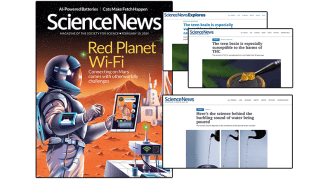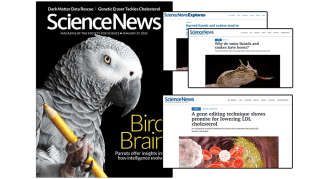Search Results
Social Media Smarts
Social media is part of our everyday lives. It provides entertainment, news, reference information, and so much more. However, not all the content we find on social media is accurate. In this activity, students will investigate the prevalence of misinformation on popular social media platforms. In their investigation, students examine how platforms’ biases and algorithms influence the type of content social media users see and the level of misinformation displayed.

Water Burbling Physics and THC and the Teenage Brain
Have students investigate the physical science behind everyday phenomena, like the sound of running water, and critically analyze the potential risks of consuming THC-products using these lesson plans paired to two Science News articles from the February 10 issue.
Cannabis and the Teenage Brain
Being legal doesn't mean a drug is harmless. As the adult legal access to cannabis products goes up, teens' perception of cannabis risks falls. Learn how science reveals the harm THC may pose to teens while answering questions and discussing how the evidence from such studies supports conclusions.
The physics behind burbling water
The sound of running water can evoke thirst or make for a relaxing environment. Physicists have recently figured out what causes the burbling of this alluring sound. Get your students thinking critically about this everyday phenomenon and explore possible variables behind it. Then have them read about a recent scientific study that explains the physical science principles behind the burbling water.
Unsung Heroes of Science
Throughout history, many scientific discoveries and developments have changed the way we view the world. In this activity, students will learn about some of these important scientific contributions and the lesser-known scientists responsible for them. Students will then choose one of these unsung heroes of science and create an artistic piece that celebrates them and their work and contributions to science. The artistic pieces representing lesser-known scientists will be displayed together in a commemoration open to the school.

Analyze a Clinical Trial and Horned Reptiles
Engage students with news articles from the January 27 Science News issue to have them answer graphical analysis questions about a gene editing medicine’s clinical trial and comprehension questions about how evolutionary trees may help scientists determine if reptiles with a certain hunting style are more likely to have horns.
Analyze a clinical trial’s result
Patients with a genetic disorder that increases the risk of severe heart disease took a gene editing medicine called VERVE-101 in a clinical trial. Have students answer a set of graphical analysis questions to learn more about the trial’s outcomes and the scientists’ proposed next steps.
Horned reptiles may prefer to lie in wait
Horns grant advantages to some lizard species but can be a liability to others. Learn how differences in hunting styles might contribute to physical differences in lizard species. At the same time, answer questions about evolutionary trees and convergent evolution while considering the value of analogies in helping understand complex concepts.
Designing GMO Campaigns
Humans have modified organisms for millennia through selective breeding and other techniques. But only in the past few decades have people gained the ability to directly alter organisms’ DNA to create Genetically Modified Organisms (GMOs). GMOs can help advance fields such as medicine and agriculture. In this activity, students will learn more about GMOs and their uses before creating an awareness campaign to address GMO misconceptions.

AI in Bioacoustics Research and Napping Penguins
Integrate two articles from the January 13 Science News issue to have students explore how AI was used as a research tool in a recent bioacoustics bird study and how an adaptation of the chinstrap penguins’ allows them to keep their guard up while grabbing a few z’s.
AI in bioacoustics research
Scientists recently used bioacoustics and AI to study whether certain bird species still exist in the wild. Use this lesson plan to teach students about bioacoustics and instruct them to think critically about the role of AI in the research process.
Oodles of snoozes
Every little bit of rest counts. For a chinstrap penguin, about 10,000 brief snoozes each day can add up to more than 11 hours of rest. Learn how these animals adapted to their environment by managing to grab this much-needed shut-eye. And they do it without relaxing their guard. Then answer questions discussing the relationship between habitats, behavior and sleep patterns.